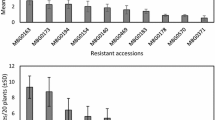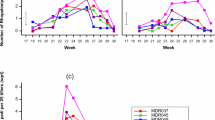Abstract
Host plant resistance is an effective protection strategy to control aphids in many crops. However, the evolution of insensitive aphid biotypes necessitates the search for new resistance sources. Wild relatives of crop plants can be important sources for resistance genes to be introgressed into new cultivars. Nasonovia ribisnigri (Mosely) (Homoptera: Aphididae) is an important pest of cultivated lettuce, Lactuca sativa. Since 1982, resistance introduced into lettuce cultivars has relied on the Nr-gene, originating from a wild relative, Lactuca virosa. In 2007 first reports appeared that Nr-based resistance had become ineffective against certain populations of N. ribisnigri. The objective of this study was to establish if the original donor of the Nr-gene L. virosa accession, IVT 280, is resistant against recently emerged virulent (Nr:1) N. ribisnigri biotypes. To this end we investigated feeding and penetration behaviour of virulent and avirulent (Nr:0) aphids on the resistant L. virosa, IVT 280, and two susceptible L. virosa accessions, using the electrical penetration graph method. Additionally, aphid performance was analysed in terms of survival, development time and reproduction on these accessions. L. virosa accession IVT 280 was resistant against all populations of N. ribisnigri tested. The ingestion of phloem was strongly reduced on the resistant accession compared to the susceptible L. virosa accessions. Additionally, none of the aphids survived on the resistant accession that, therefore, constitutes a good source of resistance in lettuce against both biotypes of N. ribisnigri.

Similar content being viewed by others
References
Alvarez AE, Tjallingii WF, Garzo E, Vleeshouwers V, Dicke M, Vosman B (2006) Location of resistance factors in the leaves of potato and wild tuber-bearing Solanum species to the aphid Myzus persicae. Entomol Exp Appl 121(2):145–157
Blackman RL, Eastop VW (2000) Aphids on the World’s Crops: an identification and information guide, 2nd edn. Wiley, Chichester
Bos L, Huijberts N (1990) Screening for resistance to big-vein disease of lettuce (Lactuca sativa). Crop Prot 9(6):446–452
Cid M, Ávila A, García A, Abad J, Fereres A (2012) New sources of resistance to lettuce aphids in Lactuca spp. Arthropod Plant Interact 6(4):1–15
Cole RA (1994) Locating a resistance mechanism to the cabbage aphid in two wild Brassicas. Entomol Exp Appl 71(1):23–31
Crute IR (1992) From breeding to cloning (and back again)—a case-study with lettuce downey mildew. Annu Rev Phytopathol 30:485–506
Dieleman FL, Eenink AH (1980) Breeding lettuce (Lactuca sativa) for resistance to the aphid Nasonovia ribisnigri. In: Minks AK, Gruys P (eds) Intergrated control of insect pests in the Netherlands. Centre for Argicultural Publishing and Documentation, Wageningen, pp 183–185
Dogimont C, Bendahmane A, Chovelon V, Boissot N (2010) Host plant resistance to aphids in cultivated crops: genetic and molecular bases, and interactions with aphid populations (Les pucerons : modèles biologiques et ravageurs des cultures). C R Biol 333(6–7):566–573
Dreyer DL, Campbell BC (1987) Chemical basis of host-plant resistance to aphids. Plant Cell Environ 10(5):353–361
Dwivedi SL, Upadhyaya HD, Stalker HT, Blair MW, Bertioli DJ, Nielen S, Ortiz R (2008) Enhancing crop gene pools with beneficial traits using wild relatives. In: Plant breeding reviews. Wiley, New York pp 179–230
Eenink AH, Groenwold R, Dieleman FL (1982) Resistance of lettuce (Lactuca) to the leaf aphid Nasonovia ribis nigri. 1. Transfer of resistance from L. virosa to L. sativa by interspecific crosses and selection of resistant breeding lines. Euphytica 31(2):291–299
Hajjar R, Hodgkin T (2007) The use of wild relatives in crop improvement: a survey of developments over the last 20 years. Euphytica 156(1–2):1–13
Jun TH, Rouf Mian MA, Michel AP (2012) Genetic mapping revealed two loci for soybean aphid resistance in PI 567301B. Theor Appl Genet 124(1):13–22
Kumar S, Atri C, Sangha M, Banga S (2011) Screening of wild crucifers for resistance to mustard aphid, Lipaphis erysimi (Kaltenbach) and attempt at introgression of resistance gene(s) from Brassica fruticulosa to Brassica juncea. Euphytica 179(3):461–470
Lambert P, Pascal T (2011) Mapping Rm2 gene conferring resistance to the green peach aphid (Myzus persicae Sulzer) in the peach cultivar “Rubira®”. Tree Genet Genome 7(5):1057–1068
Le Roux V, Campan EDM, Dubois F, Vincent C, Giordanengo P (2007) Screening for resistance against Myzus persicae and Macrosiphum euphorbiae among wild Solanum. Ann Appl Biol 151(1):83–88
Lombaert E, Carletto J, Piotte C, Fauvergue X, Lecoq H, Vanlerberghe-Masutti F, Lapchin L (2009) Response of the melon aphid, Aphis gossypii, to host-plant resistance: evidence for high adaptive potential despite low genetic variability. Entomol Exp Appl 133(1):46–56
Maisonneuve B, Chovelon V, Lot H (1991) Inheritance of resistance to beet Western Yellows Virus in Lactuca virosa L. HortScience 26(12):1543–1545
McCreight JD (2008) Potential sources of genetic resistance in Lactuca spp. to the lettuce aphid, Nasonovia ribisnigri (Mosely) (Homoptera: Aphididae). HortScience 43(5):1355–1358
McCreight JD, Liu YB (2012) Resistance to lettuce aphid (Nasonovia ribisnigri) biotype 0 in wild lettuce accessions PI 491093 and PI 274378. HortScience 47(2):179–184
Murugan M, Khan SA, Cardona PS, Orozco GV, Viswanathan P, Reese J, Starkey S, Smith CM (2010) Variation of resistance in barley against biotypes 1 and 2 of the Russian wheat aphid (Hemiptera: Aphididae). J Econ Entomol 103(3):938–948
Pompon J, Quiring D, Giordanengo P, Pelletier Y (2010) Role of host-plant selection in resistance of wild Solanum species to Macrosiphum euphorbiae and Myzus persicae. Entomol Exp Appl 137(1):73–85
Pompon J, Li XQ, Pelletier Y (2011) Resistance level to an aphid potato pest varies between genotypes from the same Solanum accession. J Econ Entomol 104(3):1075–1079
Radcliffe EB (1982) Insect pests of potato. Annu Rev Entomol 27:173–204
Sarria E, Cid M, Garzo E, Fereres A (2009) Excel Workbook for automatic parameter calculation of EPG data. Comput Electron Agric 67(1–2):35–42
Sauer-Kesper CL, Buser H, Vogler U (2011) Bedeutung und Verbreitung des neuen Biotyps-Nr:1 der Grünen Salatlaus in der Deutschschweiz. Pflanzenbau-Agrarforschung Schweiz 10:462–469
Smith CM (1989) Plant resistance to insects. A fundamental approach. Wiley, Chichester
Stufkens MAW, Teulon DAJ (2003) Distribution, host range and flight pattern of the lettuce aphid in New Zealand. New Zeal Plant Prot 56:27–32
Tagu D, Klingler JP, Moya A, Simon JC (2008) Early progress in aphid genomics and consequences for plant-aphid interactions studies. Mol Plant Microbe Interact 21(6):701–708
ten Broeke CJM, Dicke M, Van Loon JJA (2013a) Feeding behaviour and performance of different populations of the black currant-lettuce aphid, Nasonovia ribisnigri, on resistant and susceptible lettuce. Entomol Exp Appl. In press
ten Broeke CJM, Dicke M, Van Loon JJA (2013b) Performance and feeding behaviour of two biotypes of the black currant-lettuce aphid, Nasonovia ribisnigri, on resistant and susceptible Lactuca sativa near-isogenic lines. Bull Entomol Res. doi:10.1017/S0007485312000880
Thabuis APP, Teekens KC, Van Herwijnen ZO (2011) Lettuce that is resistant to the lettuce aphid Nasonovia ribisnigri biotype 1. WIPO PCT/EP2010/067588
Tjallingii WF (1988) Electrical recording of stylet penetration activities. In: Minks AK, Harrewijn P (eds) Aphids: their biology, natural enemies and control, vol 2., BElsevier Science Publishers, Amsterdam, pp 95–108
van Helden M, Tjallingii WF (1993) Tissue localisation of lettuce resistance to the aphid Nasonovia ribisnigri using electrical penetration graphs. Entomol Exp Appl 68(3):269–278
Acknowledgments
Stichting Technologisch Top Instituut Groene Genetica (TTI-GG project 2CFD022RP) and Keygene N.V are acknowledged for financial support.
Author information
Authors and Affiliations
Corresponding author
Electronic supplementary material
Below is the link to the electronic supplementary material.
Rights and permissions
About this article
Cite this article
ten Broeke, C.J.M., Dicke, M. & van Loon, J.J.A. Resistance to a new biotype of the lettuce aphid Nasonovia ribisnigri in Lactuca virosa accession IVT280. Euphytica 193, 265–275 (2013). https://doi.org/10.1007/s10681-013-0941-z
Received:
Accepted:
Published:
Issue Date:
DOI: https://doi.org/10.1007/s10681-013-0941-z




